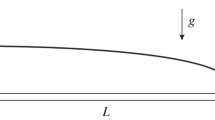Abstract
Within the Stokes film approximation, unsteady spreading of a thin layer of a heavy viscous fluid along a horizontal superhydrophobic surface is studied in the presence of a given localized mass supply in the film. The forced (induced by the mass supply) spreading regimes are considered, for which the surface tension effects are insignificant. Plane and axisymmetric flows along the principal direction of the slip tensor of the superhydrophobic surface are studied, when the corresponding slip tensor component is either a constant or a power function of the spatial coordinate, measured in the direction of spreading. An evolution equation for the film thickness is derived. It is shown that this equation has self-similar solutions of a source type. The examples of self-similar solutions are constructed for power and exponential time dependences of mass supply. In the final part of the paper, some of the solutions constructed are generalized to the case of a weak dependence of the flow on the second spatial coordinate, caused by a slight variability of the slip coefficient in the direction normal to that of spreading. The constructed self-similar solutions can be used for experimental determination of the parameters important for hydrodynamics, e.g. the slip tensor components of commercial superhydrophobic surfaces.
Similar content being viewed by others
References
A. Lafuma and D. Quere, “Superhydrophobic States, Nature Materials 2, 457–463 (2003).
A.B.D. Cassie and S. Baxter, “Wettability of Porous Surfaces,” Trans. Faraday Soc. 40, 546–551 (1940).
J.P. Rothstein, “Slip on Superhydrophobic Surfaces,” Annu. Rev. Fluid Mech. 42, 89–102 (2010).
M.Z. Bazant and O.I. Vinogradova, “Tensorial Hydrodynamic Slip,” J. Fluid Mech. 2008. V. 613. P. 125–134 (2008).
K.K.S. Lau, J. Bico, K.B.K. Teo, et al. “Superhydrophobic Carbon Nanotube Forests,” Nano Letters 3(12), 1701–1705 (2003).
A.A. Darhuber A.A. and S. M. Troian, “Principles of Microfluidic Actuation,” Annu. Rev. Fluid Mech. 37, 425–455 (2005).
A.V. Belyaev and O.I. Vinogradova, “Effective Slip in Pressure-Driven Flow Past Superhydrophobic Stripes,” J. Fluid Mech. 652, 489–499 (2010).
P.C. Smith, “A Similarity Solution for Slow Viscous Flow Down an Inclined Plane,” J. Fluid Mech. 58(Pt. 2), 275–288 (1973).
H.E. Huppert, “The Propagation of Two-Dimensional and Axisymmetric Viscous Gravity Currents Over a Rigid Horizontal Surface,” J. Fluid Mech. 121, 43–58 (1982).
J.R. Lister, “Viscous Flows Down an Inclined Plane from Point and Line Sources,” J. Fluid Mech. 242, 631–653 (1992).
A.A. Osiptsov, “Three-Dimensional Isothermal Lava Flows on a Non-Axisymmetric Conical Surface,” Fluid Dynamics 41(2), 198–210 (2006).
A.A. Osiptsov, Asymptotic Solutions of the Problems of Lava Flows on a Substrate Surface [in Russian], (Diss. Cand. Phys.-Math. Sci., M.V. Lomonosov Moscow State University, Moscow, 2005).
V.V. Pukhnachev and V.A. Solonnikov, “On the Dynamic Contact Angle Problem,” Prikl. Matem. Mekh. 46(6), 961–971 (1982).
P.G. De Gennes, “Wetting: Statics and Dynamics,” Rev. Modern Phys. 57, 827–863 (1985).
Y.D. Shikhmurzaev, Capillary Flows and Forming Interfaces (Chapman and Hall, New York, 2008).
B.K. Kopbosynov and V.V. Pukhnachev, “Thermocapillary Flow in Thin Liquid Films,” Fluid Mechanics-Soviet Research 15(1), 95–106 (1986).
A. Oron, S.H. Davis, and S.G. Bankoff, “Long-Scale Evolution of Thin Films,” Rev. Modern Phys. 69(3) 931–980 (1997).
A. Munch, B. Wagner, and T.P. Witelski, “Lubrication Models with Small to Large Slip Length,” J. Eng. Mathem. 53(3–4), 359–383 (2005).
A.A. Koltunov and I.V. Chernyshev, “Spreading of a Liquid Droplet on a Non-Uniform Saturated Porous Layer,” Vestn. Volgogr. Reg. Univ. Ser. Mathematics. Physics (1), 27–35 (2012).
Author information
Authors and Affiliations
Corresponding author
Additional information
Original Russian Text © A.I. Ageev, A.N. Osiptsov, 2014, published in Izvestiya Rossiiskoi Akademii Nauk, Mekhanika Zhidkosti i Gaza, 2014, Vol. 49, No. 3, pp. 37–51.
Rights and permissions
About this article
Cite this article
Ageev, A.I., Osiptsov, A.N. Self-similar regimes of liquid-layer spreading along a superhydrophobic surface. Fluid Dyn 49, 330–342 (2014). https://doi.org/10.1134/S0015462814030041
Received:
Published:
Issue Date:
DOI: https://doi.org/10.1134/S0015462814030041




